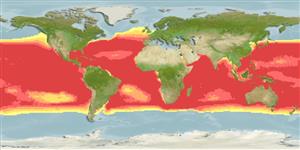Classificação / Names
Common names from other countries
Referência principal
Tamanho / Peso / Idade
Max length : 239 cm FL macho/indeterminado; (Ref. 40637); common length : 150 cm FL macho/indeterminado; (Ref. 168); Peso máx. publicado: 200.0 kg (Ref. 26550); Idade máx. registada: 9 anos (Ref. 72462)
Length at first maturity
Lm 103.3, range 78 - 158 cm
Ambiente
; marinhas; estuarina; oceanódromos (Ref. 51243); intervalo de profundidade 1 - 250 m (Ref. 6390), usually 1 - 100 m (Ref. 55289)
Clima / Intervalo
Tropical; 15°C - 31°C (Ref. 168), preferred 28°C (Ref. 107945); 59°N - 48°S, 180°W - 180°E
Distribuição
Worldwide in tropical and subtropical seas, but absent from the Mediterranean Sea. Highly migratory species, Annex I of the 1982 Convention on the Law of the Sea (Ref. 26139).
Países | Áreas FAO | Ecossistemas | Ocorrências | Introduções
Descrição suscinta
Espinhos dorsais (total): 11 - 14; Raios dorsais (total): 12-16; Espinhos anais 0; Raios anais : 11 - 16; Vértebras: 39. Fish with very long second dorsal fin and anal fin, which in some may reach well over 20% of the FL. The pectoral fin is moderately long, usually reaching beyond the second dorsal fin origin but not beyond the end of its base. Color is black metallic dark blue changing through yellow to silver on the belly. The belly frequently has about 20 broken, nearly vertical lines. The dorsal and anal fins and finlets are bright yellow.
Status na Lista Vermelha da IUCN (Ref. 115185)
Perigo para os humanos
Harmless
Uso pelos humanos
Pescarias: altamente comercial; Aquacultura: experimental; peixe esportivo: sim
Ferramentas
Relatórios especiais
Baixar XML
Fontes da internet
Estimates of some properties based on models
Phylogenetic diversity index
PD50 = 0.5039 many relatives (e.g. carps) 0.5 - 2.0 few relatives (e.g. lungfishes)
Nível Trófico
4.4 ±0.4 se; Based on diet studies.
Resiliência
Médio, tempo mínimo de duplicação da população 1,4 - 4,4 anos (K=0.13-0.42; tm=2-5; tmax=8; Fec=200,000)
Vulnerabilidade
Moderate to high vulnerability (46 of 100)
Categoria de preço
